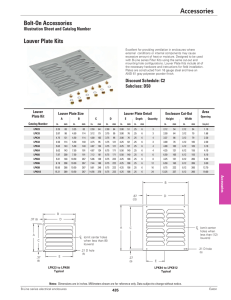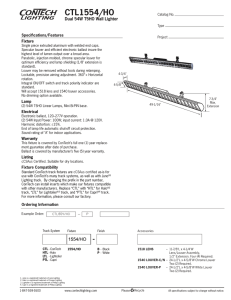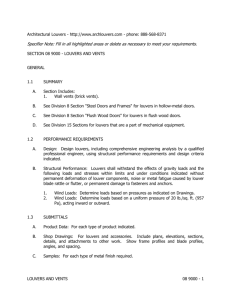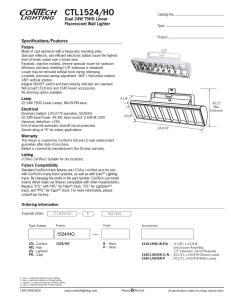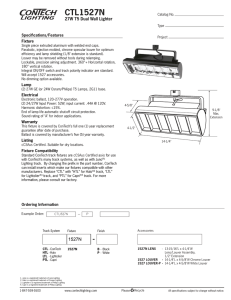field assembly and installation instructions
advertisement
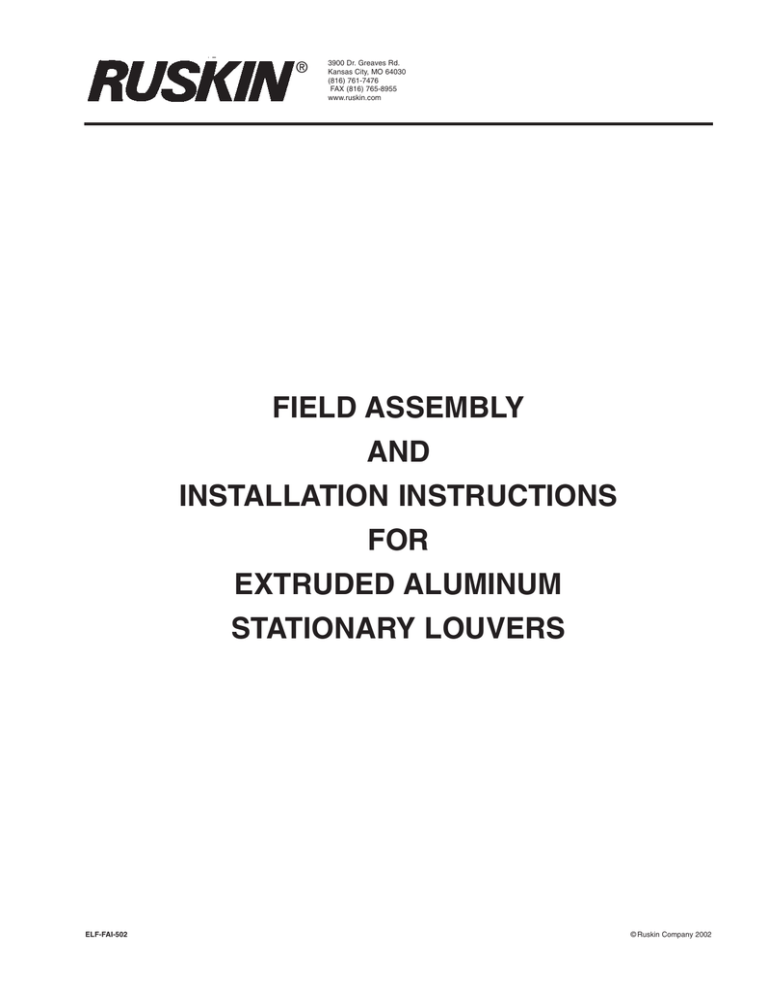
® 3900 Dr. Greaves Rd. Kansas City, MO 64030 (816) 761-7476 FAX (816) 765-8955 www.ruskin.com FIELD ASSEMBLY AND INSTALLATION INSTRUCTIONS FOR EXTRUDED ALUMINUM STATIONARY LOUVERS ELF-FAI-502 © Ruskin Company 2002 TABLE OF CONTENTS Pg. 2&3 4 5 6 7 8 9 10 11 12 13 14 15 16 Description Instructions Visible Mullion Exploded Drawing Architectural Style Exploded Drawing Vertical Visible Mullion Bolted Connection 70-020143-00B Vertical Frame Connection (2” x 4” Plates) 70-020258-00B Horizontal Visible Mullion Connection 70-020904-00B Horiz./Vert. Visible Mullion Connection 70-020300-00B Blade Support (HVBS) Splice 70-020163-00B Architectural Vertical Mullion Connection 70-020162-00B Architectural Horiz./Vert. Mullion Connection 70-020164-00B Perimeter Frame Splice 70-020165-00B Recessed Vertical Mullion Connection 60-021807-00B Extended Sill Joint Detail 60-021808-00B Typical Louvered Door Detail 60-021338-00B FIELD ASSEMBLY AND INSTALLATION INSTRUCTIONS FOR EXTRUDED ALUMINUM STATIONARY BLADE LOUVERS This booklet is provided to offer basic assembly and installation instructions for standard Ruskin extruded aluminum stationary blade louvers. While these instructions should be useful for most standard models and applications, “special” louver designs or installation conditions may not be covered. If job-specific submittal/shop drawings were generated for the order, refer to them for special field assembly and installation details. Ruskin louvers are designed to withstand 20 psf windloads unless otherwise instructed. Since Ruskin louvers may be installed in a variety of substrates, installation fasteners to anchor the louver to the substrate are typically not designed or provided by Ruskin. Consult the Engineer of Record on your project for the size, type and quantity of fasteners required. RECEIVING/INSPECTION Upon delivery, inspect shipping containers and contents closely. If shipping containers are damaged, contents could also be damaged. Note any damage on trucker’s delivery receipt. Contact the freight company within 24 hours for inspection. All products are shipped f.o.b. Ruskin plant; receiver of the shipments is responsible for filing freight claims with the freight company. STORAGE Store in an orderly manner at a safe location away from construction traffic, material, etc. to prevent damage. Cover with plastic sheeting to protect from excessive moisture, dirt and debris. DRAWING EXPLANATION This booklet contains several drawings that are provided for use in field assembly of multiple section louvers. Field assembly generally consists of joining frames and hidden vertical blade supports (HVBS) together. The style of construction dictates what type and how many of these joint connections are required. Ruskin extruded stationary blade louvers are constructed in two typical construction types: Visible Mullion and Architectural Style. Visible Mullion construction is typical with most drainable blade models. This construction utilizes perimeter frames and side frames on all louver sections. They may or may not have intermediate top and bottom frames on all sections. Architectural Style construction is typical with most non-drainable models. This construction utilizes frames only at the perimeter of the louver. Frames are not used on intermediate section joints. Both construction types typically utilize intermediate HVBS members within individual sections for windload support. After the assembly and installation sections, exploded views of Visible Mullion and Architectural Style construction louvers with detail drawing callouts are provided. Following the exploded drawings are the detail drawings they reference which depict the louver frame and HVBS connections required for each. Identify which type of louver construction applies to your order and utilize the appropriate details to assemble the louvers. 2 PRE-ASSEMBLY 1. Remove louvers and accessories from shipping containers and inspect for damage. Single section units will be shipped fully assembled. Multiple section units will be shipped in shipping sections to be assembled at the job site. Large multiple section units may be packaged in more than one shipping crate. Reference the crate identification tags and bill of lading to determine crate contents. Care must be taken when handling components. Lift louver sections carefully by the supports or frames; avoid lifting by the louver blades. Do not apply excessive force to any one point of the section. Lift at multiple points, if necessary, to avoid deformation or racking of components. 2. Inspect louvers and components after removal from containers. Verify that all components and fasteners are accounted for. Use the exploded drawings and details found in this booklet to identify parts. Report any shortages immediately to the Ruskin plant that manufactured the louver(s). 3. Inspect the openings that the louvers will be installed in. Verify that the openings are square and that the unit will fit prior to installation. Check available installation depth for possible HVBS interference. IF HVBS must be notched or modified for installation, secure the HVBS to a suitable substrate as close to the modification as possible to maintain structural integrity. Contact your local Ruskin representative if you have questions pertaining to this or other field modifications. SINGLE SECTION INSTALLATION 1. Install head and/or extended sill flashing in opening, if applicable (fasteners not provided by Ruskin). Caulk the heads of penetrating fasteners and any flashing joints. 2. If perimeter clip or continuous angles are utilized in installation, locate and anchor them in the opening. 3. Place the louver assembly in the opening. 4. Using shims, level the louver assembly both horizontally and vertically in the opening (shims are not provided by Ruskin). Position the louver in the opening so that the desired sealant joint will be maintained around the perimeter. 5. When louver is level and in proper position, install fasteners through the installation angles into the louver. If the louver is to be installed with fasteners through the frames into substrate or with glazing adapters into window frames, make these connections now. 6. After louver is secured, install backer rod and sealant around louver perimeter (backer rod and sealant is not provided by Ruskin). MULTIPLE SECTION ASSEMBLY/INSTALLATION 1. Install head and/or extended sill flashing in opening, if applicable (fasteners not provided by Ruskin). Long lengths of flashing will be provided in sections. Apply a continuous bead of caulk at heads of penetrating fasteners and any section seam where moisture could seep. 2. Locate loose-shipped hardware required for louver assembly. 3. Position the louver sections face down on a level, non-abrasive surface in the configuration they will be assembled in. Reference the tag numbers on each section to ensure the sections are in the correct order. 4. Fasten the sections together at the frame and HVBS joints. Refer to appropriate exploded and detail drawings in this booklet for splice hardware identification and location. 5. If perimeter clip or continuous angles are utilized in installation, locate and anchor them in the opening. 6. Carefully lift the assembled louver and place it in the opening. Be careful to lift by frames and HVBS members only; do not lift by louver blades. 7. Using shims, level the louver assembly both horizontally and vertically in the opening (shims are not provided by Ruskin). Position the louver in the opening so that the desired sealant joint will be maintained around the perimeter. 8. On architectural style units, check blade alignment at the vertical joints. Loosen section-connecting hardware and adjust the position of the sections as required to achieve good blade-to-blade alignment. When alignment is complete, tighten all section-connecting hardware. 9. When louver is level and in proper position, install fasteners through the installation angles into the louver. If the louver is to be installed with fasteners through the frames into substrate or by glazing adapters into window frames, make these connections now. 10. After louver is secured, install backer rod and sealant around louver perimeter (backer rod and sealant is not provided by Ruskin). Also apply backer rod and sealant at section joints where possible. 3 4 5 6 7 8 9 10 11 12 13 14 15 16
